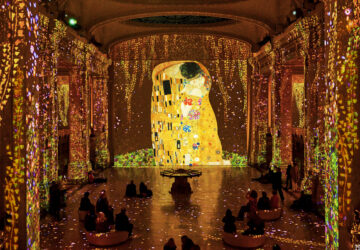JR’s The Inside Out Project really got me thinking. At Untapped, we’ve always been fascinated by graffiti because of what it says about a society’s counterculture, its disruption of the sanctity of public space and of course, its aesthetic place. But the creators of graffiti are often faceless and solitary, forced by the line of legality to remain in the shadows. JR’s work manages to transcend that boundary.
He began his work in Clichy Montfermeil, a suburb outside of Paris. At the onset of the 2005 riots, the first car burnt right in front of one of his oversized pictures catapulting him to fame. He returned to Clichy in 2006 to photograph the residents, asking them to make caricatures of themselves, how they believe Parisians see them. He took this concept to the Palestinian/Israeli border, photographing people on both sides of the wall making caricature faces as the other side perceives them. He pasted the blown-up photographs on the opposite side. Of the Israel/Palestinian experience, he found himself surprised: “The limits in that place are not where you think they are.” In his creative process, there is also the sense of realization. He found that “the real heroes are not where you think they are. They are right in there in the middle of the street everywhere around you.”
JR is eloquent and you can really feel this exploration of boundaries and limits when he speaks. His work looks to destabilize the concept of the lone, elusive graffiti artist by involving the residents in the end-product. He also pinpoints the keys to understanding a society. In Africa, he found that the men were “holding the street,” wary and confrontational about the photographers’ presence but the women “reveal the whole condition of society.” He focused on the eyes of the women he photographed, pasting their enlarged photographs all over their cities–on stairs, the facades of houses, on top of trains. His search for the unsung hero continued in Africa, where he found that”anonymous women are [the] daily heroes.” There is even an architectural and philanthropic bent to his work. In some cases, the material of the printed photographs were vinyl, protecting homes in slums/informal settlements from rain.
But most tellingly, JR says he wants to go back and continue the stories he’s formed with the people he meets: “The experience with those people was so strong that it makes us want to come back, keep a link with those people.” It’s not surprising then that he wants to bring this to the world.
Now YOU can be involved in JR’s Inside Out Project either in person or online. As part of the TED Prize, he’s set up a photo booth at the Centre Pompidou in Paris that will print out the oversized photographs. The website says, INSIDE OUT is a large-scale participatory art project that transforms messages of personal identity into pieces of artistic work. Upload a portrait. Receive a poster. Paste it for the world to see.
Join the revolution!





